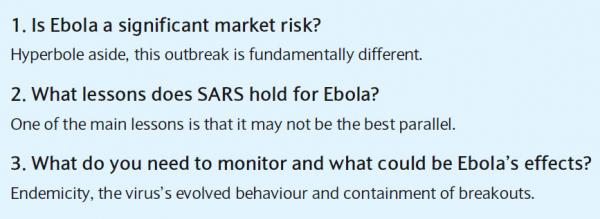Barclays’ FX Research team explains why Ebola can no longer be ignored…

Â
1. Is Ebola a significant market risk?
Before the current Ebola outbreak began in December, the disease was already notorious and fear inspiring despite having afflicted only 2,345 people in the 37 years since its discovery, nearly all of whom were in remote villages in Central Africa and 1,546 of whom died. Yet, as long as sporadic outbreaks remained contained and confined, it had little impact on the global economy or markets. The current outbreak in West Africa may be changing that.
The West African Ebola outbreak that began in Guinea is notably different from prior outbreaks in ways that significantly increase its chances of having a broader impact. In particular, Ebola’s likelihood of spreading to larger, more integrated economies has increased. It remains a tail risk, but has jumped in probability to one that can no longer be ignored.
There are several important differences between this Ebola outbreak and previous episodes.
First is its size: confirmed cases and mortalities – 4,087 and 2,071, respectively – already are greater than all prior outbreaks combined and growing at an uncontrolled pace. Including probable and suspected cases increases those numbers to 7,470 and 3,431, respectively (Figure 1), and both the US Centers for Disease Control (CDC) and the World Health Organization (WHO) believe these numbers are underestimated, perhaps by a factor of 2.5.

Â
Second, the current outbreak is more urban than prior outbreaks, with Freetown, Sierra Leone and Monrovia, Liberia being among the hardest hit areas.
Third, and perhaps most importantly, the current outbreak is on the edge of a vast, densely populated area of 334 million people that is an ideal breeding ground for disease (Figure 3). As Robert Kaplan described it 20 years ago when its population was about half as large, “the Lome-Abidjan coastal corridor – indeed, the entire stretch of coast from Abidjan eastward to Lagos – is one burgeoning megalopolis that by any rational economic and geographical standard should constitute a single sovereignty, rather than the five (the Ivory Coast, Ghana, Togo, Benin, and Nigeria) into which it is currently divided.†Somewhat presciently, Kaplan noted this densely populated, impoverished, crime-ridden area was a perfect Petri dish for pestilence.

Figure 2 presents statistics on some of the socio-economic and health factors that make the region particularly susceptible to disease. The region’s young population – median age is 18.3 years – suffers the worst of poverty’s fellow travellers, including low literacy rates, poor access to clean water and to improved sanitation, and few health professionals and facilities. Illiteracy and residual warlordism from recent civil wars were key contributors to the rapid spread of Ebola in Sierra Leone and Liberia as health workers had difficulty educating a distrustful population on prevention, and in cases have been attacked on rumors they brought the disease. Making matters worse, Ebola has disproportionately stricken healthcare workers, reducing already low ratios to the general population.

A fourth difference is an active debate over how contagious the virus is now and what its potential to become more contagious is. Researchers have established that Ebola’s genetic structure is subject to a rapid pace of mutation and have documented numerous genetic changes to the virus, Zaire ebolavirus, one of five documented strains of Ebola, both from previous outbreaks and since the current outbreak began. The implications of these changes for the virus’s behaviour and morbidity are not yet known and will require significant further study. Health officials and researchers are not in agreement about the virus’s current and potential means of transmission. The WHO and CDC maintain that Ebola can only be transmitted via direct contact of an infected, symptomatic person’s bodily fluids with open lesions or with mucus membranes. Yet, the Public Health Agency of Canada and the Federation of American Scientists warn that aerosolized transmission, though unconfirmed in human-to-human transmission, has been documented in non-human primates and pigs.

